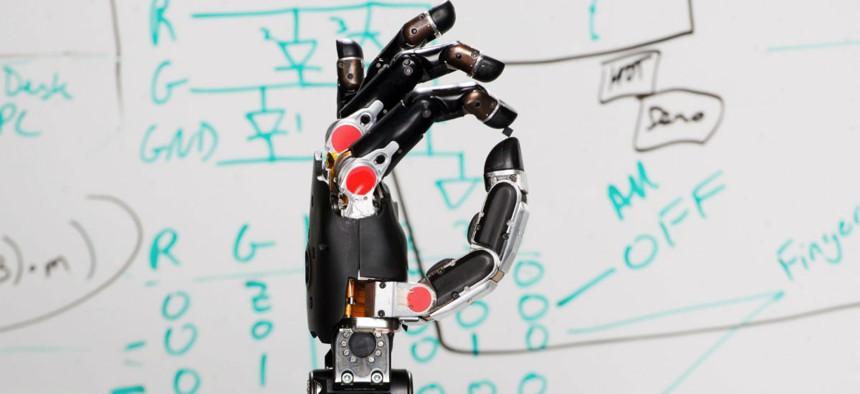This Mind-Controlled Prosthetic Robot Arm Lets You Actually Feel What it Touches

DARPA
The robotic arm is connected by wires that link up to the wearer’s motor cortex and sensory cortex.
The U.S. government said today (Sept. 11) that it’s successfully made a Luke Skywalker-like prosthetic arm that allows the wearer to actually feel things.
At a conference in July, the US Defense Advanced Research Projects Agency (DARPA) presented the achievements it’d had to date in building a robot arm that can be controlled by a human brain. A little over two months later, the agency has announced at another conference that it’s managed to update the technology to give the wearer the feeling of actually being able to sense things with the arm.
The robotic arm is connected by wires that link up to the wearer’s motor cortex—the part of the brain that controls muscle movement—and sensory cortex, which identifies tactile sensations when you touch things. The wires from the motor cortex allow the wearer to control the motion of the robot arm, and pressure sensors in the arm that connect back into the sensory cortex give the wearer the sensation that they are touching something.

According to the project’s program manager, Justin Sanchez, the team blindfolded the first person connected to the robot arm, and lightly touched his fingers. He was able to recognize which of his fingers had been touched, and even when the team tried to trick him by touching two fingers at once.
“He responded in jest asking whether somebody was trying to play a trick on him,” Sanchez said in a release. “That is when we knew that the feelings he was perceiving through the robotic hand were near-natural.”
The work is the result of a nine-year project run by DARPA called Revolutionizing Prosthetics. Sanchez announced the initial findings at DARPA’s Wait, What conference Sept. 11:
“We’ve completed the circuit,” he said. “Prosthetic limbs that can be controlled by thoughts are showing great promise.”

DARPA, however, is remaining tight-lipped on the details of the project’s success—like just how sensitive the robot arm is to different textures or surfaces—until it’s passed a peer review and been submitted to a scientific journal for publication.
Until then, we’ll just have to assume the agency has pulled off what hasn’t happened since a long time ago, in a galaxy far, far away. But—search your feelings—you know it to be true.
NEXT STORY: Will Subdrones Cause World War III?





